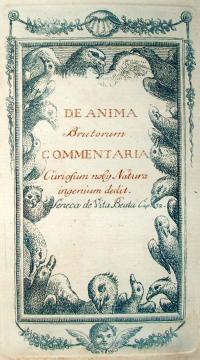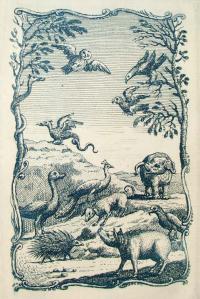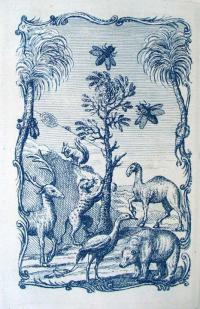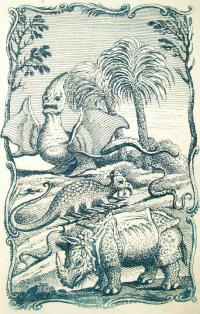Francesco Maria Soldini, De anima brutorum commentaria: curiosum nobis natura ingenium dedit (Commentary on the soul of animals: nature gave us an inquiring mind) (Florence: Cajetan Cambiagus, 1776). Frontispiece and seven additional engravings, along with engraved initials, borders, and headpieces. Artist unidentified. Graphic Arts (GAX) 2007-2116N
An odd combination of animals, real and imagined, are depicted in these lovely engraved plates, printed in various colored inks and interspersed throughout Soldini’s text. The title page is printed À la poupée, which means the plate was carefully hand inked in several colors printed altogether (instead of individual plates for each color printed separately). The process is named after the wad of cloth that was used in the inking, which looked like the head of a rag doll (poupée)
The animals include a rhinoceros, a camel, various amphibians, and even prehistoric beings. It is curious to see them all crawling or walking or flying together. I see from other copies that the plates are not always bound in the same order and the frontispiece (in ours) is not always at the front. Note, the PhotoShopping of the color of these digital imagines is not very good; not particularly close to subtle original tones in our book.
The dealer Susanne Schulz-Falster points out that the book was “issued nearly a century before Darwin’s theories of evolution” and it earned a place on the Index Librorum Prohibitarum. This was the list of publications prohibited by the Roman Catholic Church, happily abolished in 1966 by Pope Paul VI. Princeton’s earliest copy of the Index dates from 1611.
Indices expvrgatorii dvo, testes fravdvm ac falsatonium pontificiarum (Hanoviæ, apud G. Antonium, anno 1611). Rare Books (Ex) 0408.49.121
Mark Farrell, our brilliant rare book cataloguer, adds these notes about the title and its translation:
Julie, the title proper and subtitle are divided wrong. Commentaria belongs to the title proper, not to the subtitle. Also, there is no such word as nobii in Latin. The title should be transcribed thus:
De anima brutorum commentaria: curiosum nobis natura ingenium dedit: Seneca de vita beata cap. 32.
and translated thus:
Commentary on the soul of animals: nature gave us an inquiring mind: Seneca De vita beata, ch. 32 [i.e. Seneca De otio, ch. 5].
The subtitle is actually an epigraph, and it is taken from chapter 5 of Seneca’s De otio (On leisure), not, as the title page says, from chapter 32 of his De vita beata, which, by the way, has only 28 chapters. Here is a translation by Aubrey Stewart of the whole sentence:
Nature has bestowed upon us an inquiring disposition, and being well aware of her own skill and beauty, has produced us to be spectators of her vast works, because she would lose all the fruits of her labour if she were to exhibit such vast and noble works of such complex construction, so bright and beautiful in so many ways, to solitude alone.




That winged dragon beastie above the Durer rhino appears in a plate from the 1671 book on exploration of the Americas by Montanus/Moeurs (I'm not sure if this was the original however: that whole travel genre, popular at the time, inspired some heavy duty copyright infringement and 'borrowings' between books, publishers and illustrators)
thank you. we have also updated the information on the title. take a look.
I need this boook in my Emil box